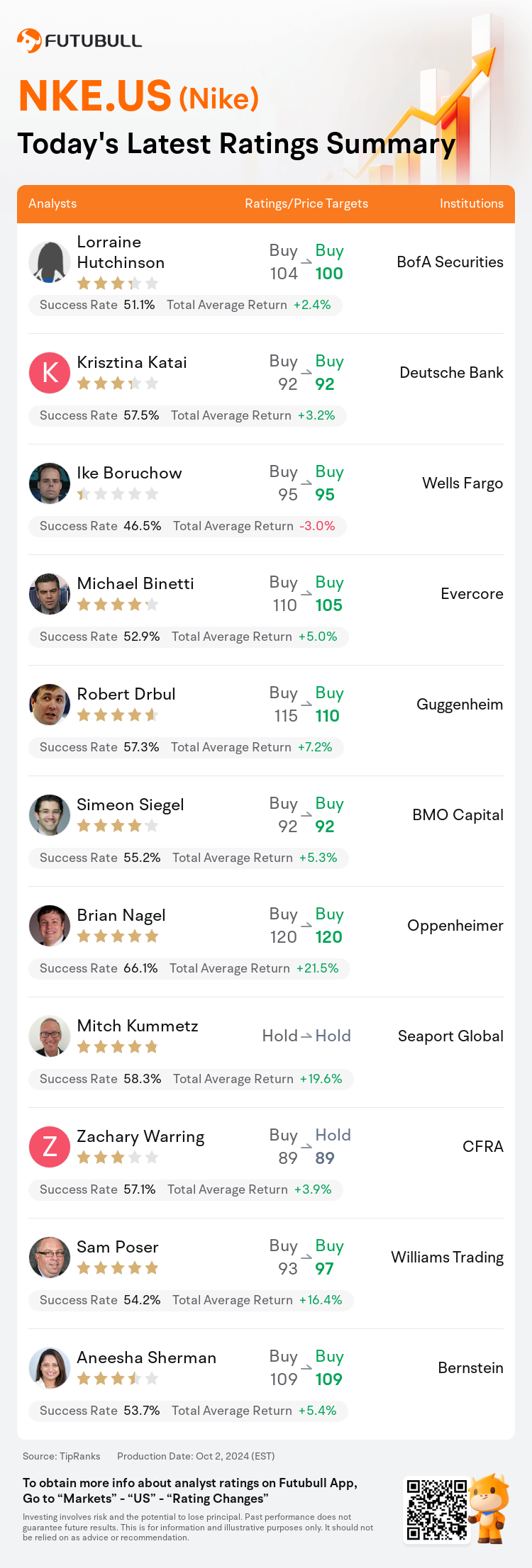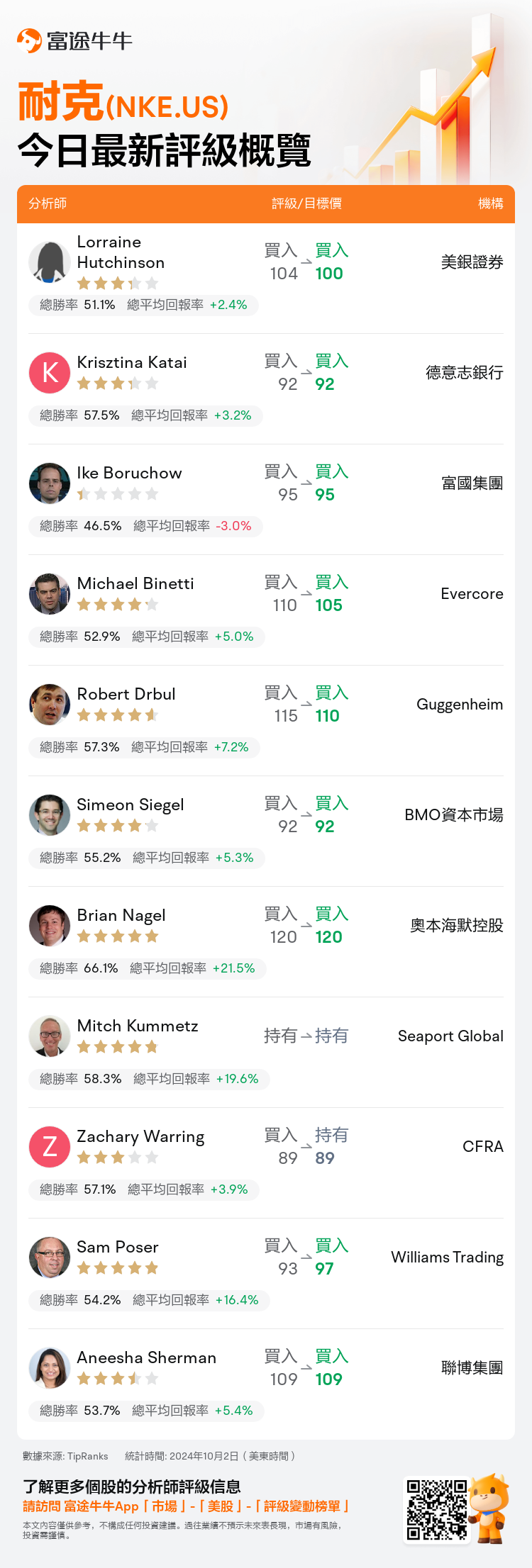On Oct 02, major Wall Street analysts update their ratings for $Nike (NKE.US)$, with price targets ranging from $89 to $120.
BofA Securities analyst Lorraine Hutchinson maintains with a buy rating, and adjusts the target price from $104 to $100.
Deutsche Bank analyst Krisztina Katai maintains with a buy rating, and maintains the target price at $92.
 Wells Fargo analyst Ike Boruchow maintains with a buy rating, and maintains the target price at $95.
Wells Fargo analyst Ike Boruchow maintains with a buy rating, and maintains the target price at $95.
Evercore analyst Michael Binetti maintains with a buy rating, and adjusts the target price from $110 to $105.
Guggenheim analyst Robert Drbul maintains with a buy rating, and adjusts the target price from $115 to $110.
Furthermore, according to the comprehensive report, the opinions of $Nike (NKE.US)$'s main analysts recently are as follows:
The latest quarterly report from Nike has solidified the perspective that the company's recovery will be prolonged, akin to a marathon rather than a swift race. The updated fiscal 2025 guidance suggests a potential decline in sales for the second half of the year by a high-single-digit percentage, differing from earlier predictions which indicated a stable outlook. This adjustment signifies a lengthier journey toward growth and sets a new baseline for future expectations. The current market demands unique creativity within the footwear industry to maintain sales, an area where Nike's innovation and narrative drive have seen a diminishing impact. There is a sense of optimism for the direction the company will take under the leadership of the incoming CEO Elliott Hill.
The company's Q1 report indicated a 10% decline in revenues year-over-year, attributed to underwhelming traffic and unit sales, which were somewhat mitigated by increased selling prices. The turnaround timeline for Nike has been perceived to be prolonged.
The recent lackluster financial report from Nike was anticipated and the viewpoint is that a more opportune moment for investment may arise once a clear trajectory towards robust and enduring growth in sales and earnings becomes evident. Nonetheless, at present, the possibility of continued downturns is considerable, with an equally heightened potential for gains, leading to a balanced risk/reward scenario. It's suggested that Nike's sales growth may persist in underperforming, particularly due to a slump in its primary product lines and market challenges in China. Additionally, there's concern that Nike's gross margin might face greater strain than foreseen as a consequence of elevated inventory levels.
Following Nike's Q1 report where earnings per share surpassed forecasts and sales saw a 10% decline, matching projections, it is believed that the upcoming leadership change with Hill's appointment as CEO later this month mitigates the risk associated with potential sales shortfalls. This change provides Hill with the leeway to execute his strategic plans.
The company's fiscal Q1 results fell short of sales expectations due to diminishing trends in both direct-to-consumer and wholesale channels. This was somewhat offset by better-than-anticipated gross margins and lower spending, which contributed to earnings surpassing estimates. However, the performance of the quarter was considered of 'low-quality' as inventory levels are now exceeding the pace of sales growth, and the guidance for Q2 was below the consensus view.
Here are the latest investment ratings and price targets for $Nike (NKE.US)$ from 11 analysts:

Note:
TipRanks, an independent third party, provides analysis data from financial analysts and calculates the Average Returns and Success Rates of the analysts' recommendations. The information presented is not an investment recommendation and is intended for informational purposes only.
Success rate is the number of the analyst's successful ratings, divided by his/her total number of ratings over the past year. A successful rating is one based on if TipRanks' virtual portfolio earned a positive return from the stock. Total average return is the average rate of return that the TipRanks' virtual portfolio has earned over the past year. These portfolios are established based on the analyst's preliminary rating and are adjusted according to the changes in the rating.
TipRanks provides a ranking of each analyst up to 5 stars, which is representative of all recommendations from the analyst. An analyst's past performance is evaluated on a scale of 1 to 5 stars, with more stars indicating better performance. The star level is determined by his/her total success rate and average return.
美東時間10月2日,多家華爾街大行更新了$耐克 (NKE.US)$的評級,目標價介於89美元至120美元。
美銀證券分析師Lorraine Hutchinson維持買入評級,並將目標價從104美元下調至100美元。
德意志銀行分析師Krisztina Katai維持買入評級,維持目標價92美元。
 富國集團分析師Ike Boruchow維持買入評級,維持目標價95美元。
富國集團分析師Ike Boruchow維持買入評級,維持目標價95美元。
Evercore分析師Michael Binetti維持買入評級,並將目標價從110美元下調至105美元。
Guggenheim分析師Robert Drbul維持買入評級,並將目標價從115美元下調至110美元。
此外,綜合報道,$耐克 (NKE.US)$近期主要分析師觀點如下:
耐克最新的季度報告鞏固了這樣的觀點,即公司的復甦將延長,就像一場馬拉松而不是一場快速的比賽。最新的2025財年指導方針表明,下半年的銷售額可能會以較高的個位數百分比下降,這與先前的預測不同,後者顯示前景穩定。這一調整意味着更長的增長之旅,併爲未來的預期設定了新的基準。當前的市場需要鞋類行業內獨特的創造力來維持銷售,而耐克的創新和敘事動力在這一領域的影響正在減弱。在即將上任的首席執行官埃利奧特·希爾的領導下,人們對公司的發展方向感到樂觀。
該公司的第一季度報告顯示,收入同比下降10%,這歸因於流量和單位銷售不佳,銷售價格上漲在一定程度上緩解了這種情況。耐克的週轉時間表被認爲很長。
耐克最近發佈的乏善可陳的財務報告是預料之中的,人們認爲,一旦銷售和收益實現強勁而持久增長的明確軌跡顯而易見,就會出現更合適的投資時機。儘管如此,目前,持續下滑的可能性很大,收益潛力也同樣增加,從而形成了平衡的風險/回報情景。有人認爲,耐克的銷售增長可能持續表現不佳,特別是由於其主要產品線的下滑以及中國的市場挑戰。此外,有人擔心,由於庫存水平上升,耐克的毛利率可能面臨比預期更大的壓力。
耐克發佈了第一季度報告,每股收益超過預期,銷售額下降了10%,與預期相符。此後,希爾在本月晚些時候被任命爲首席執行官後即將進行的領導層更迭緩解了與潛在銷售短缺相關的風險。這一變化爲希爾提供了執行其戰略計劃的餘地。
由於直接面向消費者的渠道和批發渠道的趨勢減弱,該公司第一財季的業績未達到銷售預期。毛利率好於預期和支出減少在一定程度上抵消了這一點,這使得收益超過預期。但是,該季度的業績被認爲是 「低質量」,因爲庫存水平現在已經超過了銷售增長的步伐,而且第二季度的預期低於共識。
以下爲今日11位分析師對$耐克 (NKE.US)$的最新投資評級及目標價:

提示:
TipRanks為獨立第三方,提供金融分析師的分析數據,並計算分析師推薦的平均回報率和勝率。提供的信息並非投資建議,僅供参考。本文不對評級數據和報告的完整性與準確性做出認可、聲明或保證。
TipRanks提供每位分析師的星級,分析師星級代表分析師所有推薦的過往表現,通過分析師的總勝率和平均回報率综合計算得出,星星越多,則該分析師過往表現越優異,最高爲5颗星。
分析師總勝率為近一年分析師的評級成功次數占總評級次數的比率。評级的成功與否,取決於TipRanks的虚擬投資組合是否從該股票中產生正回報。
總平均回報率為基於分析師的初始評級創建虚擬投資組合,並根據評級變化對組合進行調整,在近一年中該投資組合所獲得的回報率。
 富國集團分析師Ike Boruchow維持買入評級,維持目標價95美元。
富國集團分析師Ike Boruchow維持買入評級,維持目標價95美元。 
 Wells Fargo analyst Ike Boruchow maintains with a buy rating, and maintains the target price at $95.
Wells Fargo analyst Ike Boruchow maintains with a buy rating, and maintains the target price at $95.